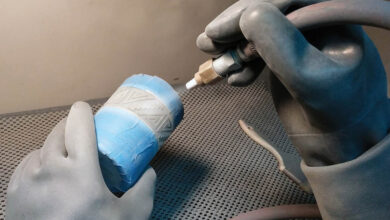Pass-through cabinets are constructed to be able to be separated into two halves (clam-shell) with thick gaskets at the seams and a way to lock the two halves together after a large piece is inserted into the cabinet. Because of this mechanism, one can actually blast glass that is larger than the cabinet. These cabinets have rollers on which the large glass can glide, as well as outriggers: additional rollers on a steel beam that are supported by legs.
All cabinets have a dust collector attached to them. In order for that to work, there not only needs to be a place where the dust collector hooks up to, but also another port with baffle to allow air to get into the cabinet. The air inlet is usually opposite of the opening where the dust collector attaches.
-Ruth Dobbins, Professional Glass Consultants



